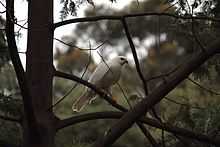Grey Goshawk
| Grey Goshawk | |
|---|---|
 | |
| Conservation status | |
| Scientific classification | |
| Kingdom: | Animalia |
| Phylum: | Chordata |
| Class: | Aves |
| Order: | Falconiformes (or Accipitriformes, q.v.) |
| Family: | Accipitridae |
| Genus: | Accipiter |
| Species: | A. novaehollandiae |
| Binomial name | |
| Accipiter novaehollandiae (Gmelin, 1788) | |
The Grey Goshawk (Accipiter novaehollandiae) the white morph of which is known as the White Goshawk, is a strongly built, medium-sized bird of prey in the family Accipitridae.
Description

The grey morph has a pale grey head and back, dark wingtips, barred grey breast and tail, and white underparts. The white morph is the only bird of prey in the world to be entirely white.[2]
Grey Goshawks are about 40–55 cm long, with wingspans of 70–110 cm. Females are much larger than males, weighing about 680 g. Males average 350 g.
Distribution and habitat
The Grey Goshawk is found along the coasts of northern, eastern and south-eastern Australia, Tasmania and rarely Western Australia, the Lesser Sunda Islands, Moluccas, New Guinea, and the Solomon Islands.
Their preferred habitats are forests, tall woodlands, and timbered watercourses.
Hunting
Goshawks usually prey on mammals such as rabbits, possums, and bats. They may also eat birds, small reptiles, and insects. Females, due to their size, can catch larger prey than males.
Hunting is often done by stealth, but Grey Goshawks are willing to pursue their prey before catching it with their talons.
Breeding
Grey and White Goshawks interbreed freely. They partner for life, breeding from July to December. They nest in tall trees on a platform of sticks and twigs with a central depression lined with green leaves. The female lays a clutch containing 2 or 3 eggs, which are incubated for about 35 days. Chicks fledge 35–40 days after hatching.
The female is usually responsible for incubating the eggs and feeding the young. The male does most of the hunting.[3]
Conservation status
State of Victoria (Australia)
- The Grey Goshawk is listed as threatened on the Victorian Flora and Fauna Guarantee Act 1988. Under this Act, an Action Statement for the recovery and future management of this species has not been prepared.
- On the 2007 advisory list of threatened vertebrate fauna in Victoria, this species is listed as vulnerable.[4]
References
- ↑ BirdLife International (2012). "Accipiter novaehollandiae". IUCN Red List of Threatened Species. Version 2013.2. International Union for Conservation of Nature. Retrieved 26 November 2013.
- ↑ Society for the Preservation of Raptors species data
- ↑ Birds in Backyards - Grey Goshawk
- ↑ Victorian Department of Sustainability and Environment (2007). Advisory List of Threatened Vertebrate Fauna in Victoria - 2007. East Melbourne, Victoria: Department of Sustainability and Environment. p. 15. ISBN 978-1-74208-039-0.
- Marchant, S.; & Higgins, P.J. (Eds). (1993). Handbook of Australian, New Zealand and Antarctic Birds. Vol,2: Raptors to Lapwings. Oxford University Press: Melbourne. ISBN 0-19-553069-1
External links
| Wikimedia Commons has media related to Accipiter novaehollandiae. |
| Wikispecies has information related to: Accipiter novaehollandiae |
